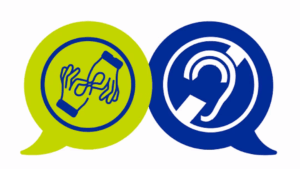Medical Interpreter VS Medical Translator?
In a healthcare setting, medical translators and interpreters are crucial to patient care. Hospital interpreters and hospital translators are only a small fraction of the wide variety of language services necessary for communication. But what’s the difference between a medical interpreter and a medical translator? How do you know if you’re choosing the right interpreting services?

To find the answer, first we need to understand the differences between interpreters and translators in any field. The simplest explanation? An interpreter interprets spoken words from one language to another and a translator translates written words. Interpreting is “out loud;” translating is a written process. However, it’s also deeper than that and the distinction can become a little convoluted in a hospital environment. Sometimes interpreting and translation are blended. How do you manage that balance? To start, let’s talk about the roles.
The Role of the Interpreter
A properly trained medical interpreter is vital to maintaining lines of communication in a healthcare setting. The right atmosphere it is when he “disappears” into the conversation, allowing two parties to converse as though they were speaking the same language. To achieve this, an interpreter moves through several roles during a session:
-
Language Conduit:
- The language conduit role makes up the biggest portion of an interpreting session. As a “language conduit,” he takes language in from one party and interprets it into the target language. The interpreter should be a bit behind and angled towards the non-English speaker. The parties should speak directly to each other.
-
Clarifier:
- An interpreter moves into the clarifier role to ask a question, confirm understanding, admit a mistake, or make a request. After clarifying, he moves back into their role as language conduit so the session can continue.
-
Culture Broker:
- An interpreter becomes a “culture broker” when they use their knowledge of their native culture to enhance understanding. For example, if one party uses a word with a double-meaning, or a culturally specific idiom, the interpreter will clarify. This preserves the meaning and makes sure that all parties are on the same page. As with the clarifier role, when the interpreter finishes they move back into their language conduit role.
-
Advocate:
- This is the most controversial role and should almost never be used. An interpreter should not advocate unless a patient is at serious, potentially life-threatening risk. It is the most intrusive role. We cover this more in our blog piece called the role of the advocate.
When switching roles, an interpreter announces this in the third person. For example, “Excuse me, the interpreter would like to make a clarification.” Then he makes the clarification and metaphorically steps back into their role as language conduit.
The Role of the Medical Translator
A medical translator, by contrast, does not work through spoken word and thus the roles of the interpreter are often irrelevant. A hospital or medical translator is only a language conduit: never a clarifier or culture broker. Hospital translation is mostly focused on files, notes, test results, and transcripts. A hospital translator must translate word for word, as closely as possible to the original text. This ensures patient safety and quality of care. This translation is extremely formal and must preserve the exact meaning of the original text. However, translation can absolutely be a collaborative process, incorporating several of the role.
When translating an academic paper or article, a translator works closely with their client. They ask the client to clarify aspects of the source text. Sometimes, the source text includes a joke that doesn’t work in another language or culture. The medical translator and client work together in this case to find a reasonable alternative.
Sight Translation
Sight translation is an example where the lines between interpreting and translation blur. This translation often happens in a medical setting. In this case, a provider asks a medical interpreter to “translate” a small form or brochure to the patient. The interpreter is not writing a translation, they’re interpreting the written words in one language to spoken words in another. Ideally, this should be done only at the urging and in the presence of a staff member.
It’s also important to note that an interpreter should not be the party who writes the patient’s answers on the form. Only a provider should do this, or the patient themselves. While it is appropriate for an interpreter to sight translate a small amount of text, it’s inappropriate to transcribe answers.
What medical language services do I need?
You now have the foundational information about the differences between a medical translator and a interpreter. But how do you know which services you need? Luckily, there’s an easy way to decide. Ask yourself:
- Am I working with a patient who’s speaking out loud? If so, you need a medical interpreter.
- Do I want text translated on paper to another language? If so, you need a medical translator.
It’s as simple as that! A reputable language services company will cover all of your needs and direct you to the right department with any questions.
Working with Interpreters in a Professional Setting: a Global Arena eLearning Course
Working effectively with interpreters is a skill as important as interpreting itself, no matter your field. At Global Arena, we offer courses not only to interpreters but to clients as well. Our eLearning course, Working with Interpreters in a Professional Setting, is an excellent way to prepare to work with interpreters. In only half an hour, you and your staff will better understand the best industry practices. The course offers an opportunity to expand your business or brush up on basic skills for working with interpreters. It’s fully online, self-paced, and accessible from any device, any time. Follow the link to learn more or register today!




